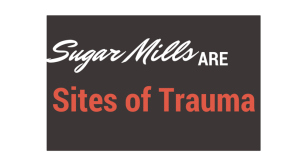It seems strange that I would have to say this but I’m just offering up a gentle reminder to those who have intentionally or unintentionally forgotten that, “Sugar Mills are sites of trauma.” Human beings were captured, brutalized, and enslaved on these islands and the sugar mill is a key site in the plantation economies of the Caribbean region where sugar was a main product.
I understand that this is a touchy subject for many of us. The sugar mills are absolutely stunning and, for some, serve as majestic remnants of colonial architecture. Furthermore, our USVI economy is tourism based. Visitors flock to our shores to see these sugar mills and they want to hike, have picnics, and host weddings in the shadows of our sites of bondage.
How do we grapple with the symbolic and material implications of using sites of trauma as props? We are not merely speaking of a historical period that has passed. The appropriation of these spaces as vehicles for tourism is also symbolic of ongoing forms of dispossession. Predominantly white visitors are able to experience moments of leisure and bliss, snap selfies in front of the sugar mills, and leave while the predominantly Black, Brown, and White creole population struggles to achieve equality, adequate education systems, and economic stability.
I’ve had several discussions about this over the years with local friends, family members, artists, and classmates. The conversations were not always pleasant. I begged my high school class not to hold our graduation at a sugar mill and we merely swapped one sugar mill, Annaberg, for another, Caneel Bay. There are many who feel as though I’m being overly sensitive or impractical. However, I’m an artist at heart and an academic by training. I can’t help but cast a conscious and critical gaze on these questions.
I dusted off some old articles that I love for these discussions. My favorite is Reading Sugar Mills: ‘The Island Nobody Spoiled’ and Other Fantasies of Colonial Desire by Grant Cornwell and Eve Studdard. I also tend to reference Jamaica Kincaid’s A Small Place. All of the aforementioned people make key observations about race relations, tourism, colonialism, and the colonial desires that these power structures produce. These fantasies are rooted deeply in historical legacies of Black and Brown servitude, adventure and leisure in unspoiled landscapes, and the commodification of beautiful islands and their dispossessed people.
It’s important to remember that the U.S. Virgin Islands are a part of these ongoing discussions of colonialism in the Caribbean region. While many Caribbean islands achieved independence, many of the American dependencies are still struggling for autonomy. Yet, this struggle is obscured by perceptions of American privilege. Kim Lyons, a local artist and activist, made a salient point, people often post wedding pictures in front of former slave plantations when they wouldn’t consider doing such a thing in front of other historical sites of trauma. In the USVI, these actions have been normalized. Thank the entities that Be that I have people like my Tauntie Marva Sylvester to remind me that it is imperative that we young people of the VI learn how to reclaim space.
In an effort to disrupt the comfort of silence, normativity, and erasure, I’m highlighting these candid comments by artists, activists, loved ones, and scholars in the V.I.
Sugar Mills are sites of Trauma! #DecolonizingtheUSVI


Very important points raised here, and ones that I also attempt to infuse throughout my ninth grade Caribbean History class. Another related excellent academic work which you should definitely read (if you haven’t already) is Mimi Sheller’s Consuming the Caribbean: From Arawaks to Zombies.
LikeLike
It’s an excellent book! I’d also love to hear more about your ninth grade Caribbean history class.
LikeLike